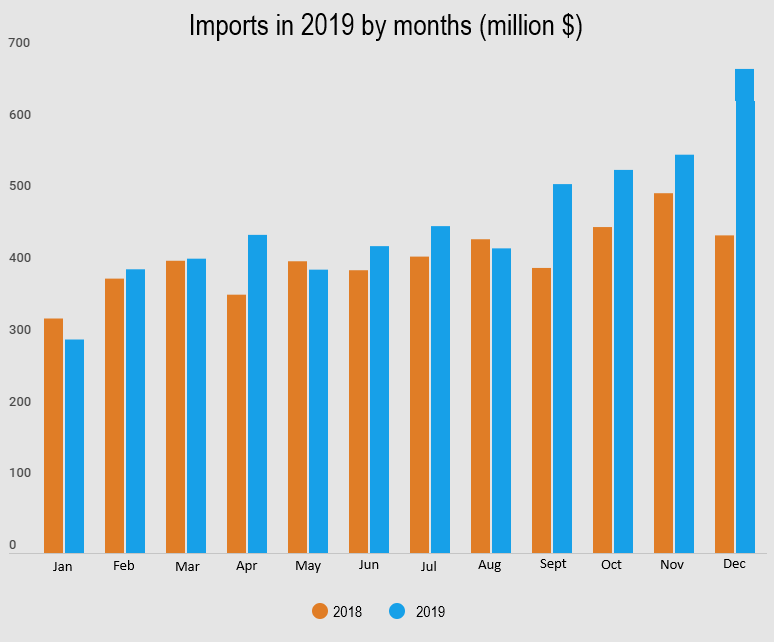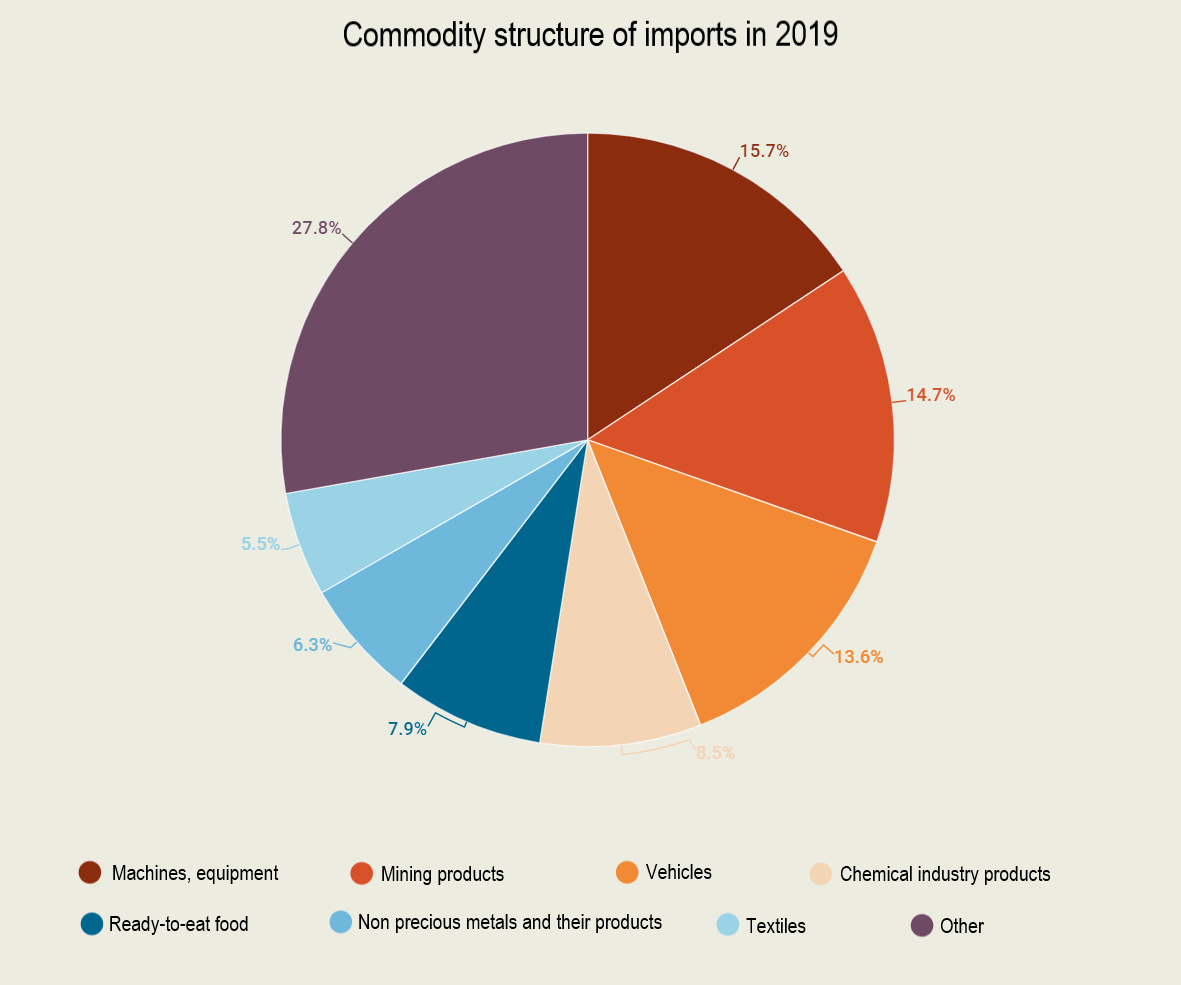- 13 April, 2020
- Economy and Energy

In 2019, commodities worth more than $ 5.5 billion were imported to Armenia. This means that compared to 2018, imports increased by 10.8%.
Prior to December, the increase in imports was insignificant compared to 2018, and in some cases it was lower than the indicators of the previous year (for example, in January, May and August). However, such an increase in imports over the year was possible due to more than 50% growth in December.
In order for it to be clear what effect this 50% growth had, it should be noted that the growth of import volumes for the 11 months of 2019 was 6.6%.
Import volumes by months are presented in the graph.
 In 2019, certain changes were observed in the commodity structure of imports. In 2018 about $ 935 million worth of machinery (not to be confused with vehicles), equipment and mechanisms were imported to Armenia. In 2019 the import volumes of this commodity group decreased by about 8%.
In 2019, certain changes were observed in the commodity structure of imports. In 2018 about $ 935 million worth of machinery (not to be confused with vehicles), equipment and mechanisms were imported to Armenia. In 2019 the import volumes of this commodity group decreased by about 8%.
As expected, the import of such equipment has led to the growth of the processing industry in the country.
The main commodities imported to Armenia are still mining products – $ 814 million (+ 12.9%), vehicles – $ 749 million (2.1 times more than in 2018), chemical products – $ 470 million (+ 19%), ready-to-eat food – $ 435 million (+ 8.9%), non-precious metals and their products – $ 345 million (+ 1․4%) and textiles – $ 301 million (-5.5%).
 Particular attention should be paid to the increase in the volume of imports of means of transport. The 210% growth recorded last year is due to the fact that EEU customs tariffs came into force on January 1, 2020.
Particular attention should be paid to the increase in the volume of imports of means of transport. The 210% growth recorded last year is due to the fact that EEU customs tariffs came into force on January 1, 2020.
The only commodity group that registered a decrease in import volumes last year (5.5%) was textile products.
Geography of imports
EEU remains Armenia’s main partner in terms of imported goods. In 2018, the share of goods imported from the member states of the Union was 29%, and last year it was already 30.7%. It goes without saying that our main partner from the EEU member states remains the Russian Federation. The share of goods imported from this country to Armenia increased by 1.6% as compared to 2018, amounting to 29.7%. About $ 1 billion 640 million worth of goods were imported from Russia last year.
Apart from the EEU member states, Armenia continues to actively trade with the CIS member states, particularly Ukraine. Last year, despite the decline in imports, about $ 150 million worth of goods were imported to Armenia from Ukraine, which makes up 2.7% of total imports.
Armenia mainly imports oil and oil products, gas and food from the CIS and EEU member states.
Despite the fact that the EEU customs tariffs are beginning to be applied to goods imported from EU member states, the EU continues to be Armenia’s second largest trading partner. Last year, about $ 1 billion 150 million worth of goods were imported to Armenia from EU member states, which is 20.8% of imports. For comparison, in 2018 the volume of goods imported from Europe to Armenia was about 25% of the total.
Germany remains Armenia’s largest trading partner among EU countries – $ 239.2 million (3.4%), Italy – $ 181.5 million (3.3%), the Netherlands – $ 131.9 million (2.4%), Belgium – $ 86.6 million (1.6%) and France – $ 65 million (1.2%).
Armenia mainly imports devices and equipment, medicines, food, footwear, and vehicles from the EU member states.
Compared to 2018, the share of goods imported to Armenia from other countries has increased. In 2018 the share of goods imported to Armenia from non-EEU and non-EU member states was 42.3%, and last year it made up 45.5% of imports.
Georgia is the leader in the volume of goods imported to Armenia from these countries – $ 484.6 million (8.8%), followed by China – $ 463.3 million (8.4%), the United States – $ 356.5 million (6.5%), Iran – $ 325․5 million (5.9%), the UAE – $ 229․4 million (4.2%), Turkey – $ 149․9 million (2.7%) and Switzerland – $ 62․6 million (1.1%).
By the way, except for Turkey and Switzerland, the volume of goods imported from all other countries has increased in double digits. For example, imports from the United States increased by 87% (mainly vehicles), from Georgia by 30%, from Iran and China by more than 20%, etc. Meanwhile, in the case of Switzerland, imports fell by more than two times, and in the case of Turkey by 7.5%.
Armenia imports mainly vehicles, equipment and communications means, construction materials, textile industry products, food, etc. from these countries.
Sevada Ghazaryan
Union of Informed Citizens




